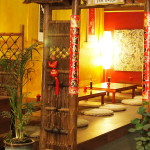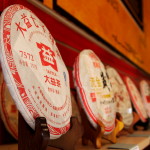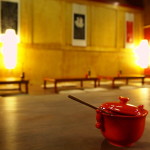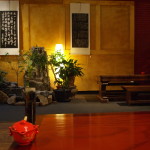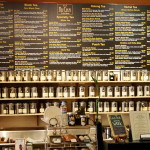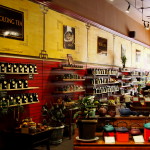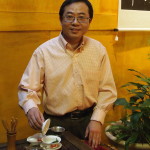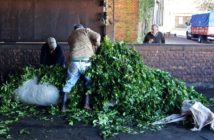Looking for a unique tea house serving tea in the Gaiwan method? You found it in the Ku Cha House of Tea, among the hustle and bustle of the well-traveled walking mall on Pearl Street, in Boulder, Colorado.
Originally from China, owners Rong Pan and Qin Liu envisioned bringing the best of Chinese tea and tea culture to Boulder. Operated by this husband-and-wife team, the Ku Cha House of Tea is both a purveyor of fine teas within a traditional Chinese tea house.
The Chinese greens are the shop’s focal point and clearly Qin’s true passion. Qin’s top Chinese green teas are: Bi Lo Chun, Long Jing (Dragon Well), Er Mei Snow Bud, Liu An Gua Pian, An Ji White, Huang Shan Mao Feng, Tai Ping Hou Kui, Xing Yang Mao Jian, Men Ding Yu Lu.
All of the tea at the Ku Cha is personally selected by Qin. He acquires the Chinese green teas, the Chinese and Taiwanese oolongs, and the puerhs. So he travels back to China for these at least two times per year, hand-selecting each one for superior quality. In addition to these Chinese and Taiwanese teas, the remaining selection is quite large by American tea house standards.
Qin spends a good deal of time every Spring travelling to choose his favorite Chinese greens, before the rains of spring begin. This is the first step in acquiring tea of the highest quality. All the Chinese green teas are stunningly clean, providing what in China they would call “the taste of the weather.”
Qin refuses to buy his Chinese green teas after the rains. Once the rains begin, tea growth and production begin to increase. With the rain though, come the bugs, and then chemicals to deflect those bugs. This is why buying first flush or “before the rains” (pre-ming) is so important to Qin, who is adamant that no chemicals be present in any of his teas.
Quin buys all his Chinese green tea in one large lot from the source of production. By doing this he runs the risk of overbuying, or running out of tea over the course of the year. To Qin this risk is worth the guarantee of superior quality. To further maintain this ethos once back home, all the tea is packaged and kept refrigerated immediately upon arrival in Boulder.
All the teas at the Ku Cha House of Tea are put into small sampling jars alongside bags for purchase. This allows for scrutinizing the leaves, as well as reading detailed descriptions on the outside labels of the small glass sampling jars, of the copious selection of tea.
Once fall arrives Qin travels back to China to select Chinese and Taiwanese oolongs as well as puerh. The oolongs of Taiwan include a Dong Ding, echoing flavors of freshly cut wood and grape skin. As for Chinese teas, they are served in the traditional gaiwan steeping of the Ku Cha’s Ti Quan Yin. This tea is vibrant, with nuances of nutty oak and stone fruit.
The tea house serves tea in the traditional gung-fu service, which is the standard tea pot, and should be experienced on any trip to the Ku Cha. For only one dollar more, the gaiwan service is available with the appropriate gaiwan tasting cups. The Ku Cha staff prefers to steep the tea for their customers; holding leaves at the front counter for any additional cups of tea they may want is part of the service. This allows clients to truly enjoy these teas the way they were intended to be- creating the final step of the tea education that Qin hopes to provide.
Elegant and simple, the tea house’s west half consists of traditional mat style seating, while the east half has modern benches and chairs. A bubbling fountain and Chinese music quietly enhances the tea experience. The Ku Cha tea house also has some decor that is just plain fun; one whole wall displays the brick teas of Asia and another wall holds different tisanes.
Rong handles the operations of the Ku Cha, and she clearly does this well. The staff is consistently knowledgeable and excited about discussing tea. For instance, when I asked one of the staff for a sample of the puerh, he lit up and spoke with bubbling enthusiasm. Then he took the time to show me the puerh cakes available and explained the subtle differences between each of them.
The puerh selection at the Ku Cha is wide by American tea house standards; but not, according to Qin, by Chinese ones. Qin explains he wants his puerh selection not to showcase the very highest end or most expensive of puerh, nor to have the most puerhs possible. Instead, Qin’s goal is to have examples that show the full breadth of the style. Qin wants to slowly introduce new puerhs – the current selection hovers around twenty- that he believes will remain available and of consistent quality. This, he feels, best introduces the westerner to the wonderful world of puerh.
Although so easily overshadowed by the copious and brilliant selection of top-rate greens, oolongs and puerhs, the rest of the tea selection is also of the foremost quality, with hidden gems everywhere. Sitting beside hand selected Single Estate Darjeeling is a Keemun An Cha, and beside that a Yunnan Gold, and beside that is the rare Ceylon- Golden Tips! It is exciting to see so many of the world’s best teas, thoroughly described and easily available for sampling.
If you find yourself in a hurry, there is standard, fast, to-go service available. But even with this service, the staff is reluctant to let you steep your own tea – they will relent, but only if they know the leaves are in good hands. Any tea lover will appreciate this level of commitment to the final cup. Spend much time here and it will seem a pity to come in and buy a cup to go, instead of pausing for reflective time around a gaiwan.
After I ordered a green tea to go, I asked if they could hold my Bi Lo Chun leaves for a second steeping later, after I did some errands around the Pearl Street mall. “Of course” was the smiling response.
Qin emphasizes that the Ku Cha tea house both seeks to educate the customer and maximize the experience of the tea. All of the Ku Cha tea houses’s teas are available for sale on their website. Though ideally Qin wants both the tea lover and the tea curious to come in and experience the tea at the tea house, and then buy tea online only if they can’t come back to the store.
Only through visiting the store, smelling and examining the leaves, being educated by the staff, and finally enjoying the tea in a traditional gaiwan can you truly appreciate the time, effort, and passion that rest in every bud and leaf that line the walls of the Ku Cha House of Tea.
note that this article was previously published June 3rd, 2014


